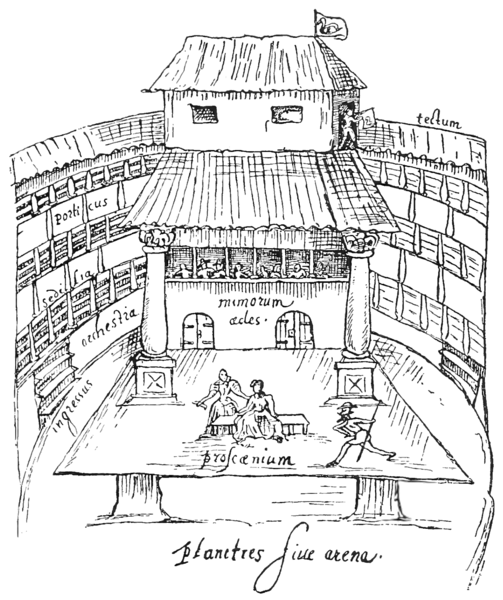Introduction to Theatre
Elizabethan Theatre
https://upload.wikimedia.org/wikipedia/commons/7/78/Elizabeth_I_when_a_Princess.jpg
Queen Elizabeth outlawed religious drama within the city limits and would not allow theatres to
be built within city limits due to fighting among religious factions. The fighting was acerbated by
the fact that 90% of theatre done at the time was liturgical. Thus the outlawing of the main subject matter of theatre at the time.
Elizabethan playwrights had to look to history, myths and legends to
fuel the dialogue and actions of the new type of theatre being written.
http://what-when-how.com/wp-content/uploads/2011/03/tmp6117_thumb.jpg
The structure of the new theatres built at this time in England is very much like circled pageant wagons. With only one side folded out to become a thrust stage, the open center circle providedsunlight. The troops of actors would live in the tiring house behind the stage. There was a balcony above the stage area where a band would play. On the roof of the theatre there was sometimes a cannon to fire in order to announce new productions opening! This also sometimes resulted in the theatre burning down. The different seating options in these theatres were ground pit standing, benches on the sides on risers, and private box seating with curtains and tables and padded chairs. Many venders and hawkers moved about the lower two seating options selling everything from meat pies to warm beer.
https://hrlibrary.wikispaces.com/file/view/elizabethan-theatre.jpg/121429169/elizabethan-theatre.jpg
Actors were all men and were typically hired depending on what costumes they carried in their trunks. High voiced weak chinned men would typically play the female roles, and thus have many female costumes in their possession.
There were no directors but the lead actor or the playwright of a troop would often oversee the
rehearsals and script changes. The blocking was very much forward and still somewhat lateral with a knod to the conventions of medieval staging.
The playwrights often wrote in meter, the more presentational and formal sound of the language
gave the dialogue a presence similar to the previous Latin or biblical texts used. Shakespeare's
works are the best known of these and commonly used Iambic Pentameter.
Elizabethan Theatre

Elizabethan Theatre Vocabulary
Guilds – organized groups of tradesmen that maintained product standards and training.
Leg – The long 6’ wide curtains that are found at the sides of the stage.
Border – The short curtains that are found at the top of the stage.
The Pit – Where the cheapest ticket holders milled about on the ground in front of the Elizabethan thrust stage.
The Benches – Slightly more expensive tickets to Elizabethan plays, still exposed to weather but aplace to sit.
The Boxes – The most expensive seating in Elizabethan theatre with tables and food and curtains.
Thrust Stage – A stage with very little space behind the Proscenium arch and more than 6 feet ofapron.
Shakespeare – An Elizabethan actor and playwright.
Iambic Pentameter – unstressed / stressed / unstressed / stressed / unstressed / stressed /
unstressed / stressed / unstressed / stressed / unstressed / stressed / unstressed / stressed / unstressed/ stressed / unstressed / stressed / unstressed / stressed.
Links:
A wonderful lecture: http://shakespearean.org.uk/elizthea1.htm
Nice facts page: http://www.william-shakespeare.info/elizabethan-theatre-facts.htm
Vocabulary
Guilds – organized groups of tradesmen that maintained product standards and training.
Leg – The long 6’ wide curtains that are found at the sides of the stage.
Border – The short curtains that are found at the top of the stage.
The Pit – Where the cheapest ticket holders milled about on the ground in front of the Elizabethan thrust stage.
The Benches – Slightly more expensive tickets to Elizabethan plays, still exposed to weather but a place to sit.
The Boxes – The most expensive seating in Elizabethan theatre with tables and food and curtains.
Thrust Stage – A stage with very little space behind the Proscenium arch and more than 6 feet of apron.
Shakespeare – An Elizabethan actor and playwright.
Iambic Pentameter – unstressed / stressed / unstressed / stressed / unstressed / stressed / unstressed / stressed / unstressed / stressed / unstressed / stressed / unstressed / stressed / unstressed / stressed / unstressed / stressed / unstressed / stressed.